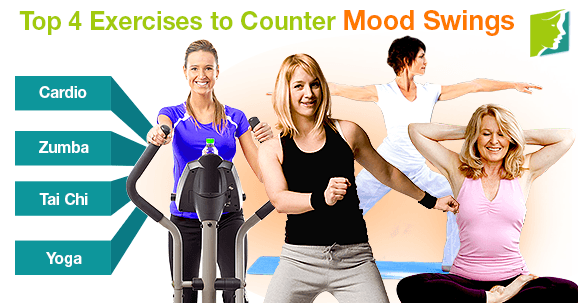During the premenopause and menopause stages, approximately 50% of women experience regular mood swings. These are brought on by hormonal imbalances that can affect emotional stability, and are not only upsetting and unpleasant for the woman experiencing them, but they can also affect relationships with a partner, family, colleagues, and friends. Exercise has been proven to help counter mood swings, but it can be difficult to know which types are best suited for this purpose. Read on for some top exercises to ease mood swings.
Tai Chi
With deep squats to strengthen leg muscles and slow, fluid movements, Tai Chi uses martial arts combined with deep breathing to achieve a relaxed state; this form of exercise can have a prolonged calming effect on your moods. It is also low-impact, which is ideal for those experiencing joint pain or those who have a lower fitness level.
Cardiovascular Workouts
High-intensity exercise (e.g., running, swimming, and cycling) prompts the brain to release feel-good chemicals, such as serotonin, adrenaline, dopamine, and endorphins, which can counter dark moods and have an uplifting effect. It can be difficult to find the motivation for this type of exercise, as it requires more physical exertion than slower-paced activities, like Tai Chi. Luckily, many gyms offer ways of exercising with other people (e.g., spinning classes or running groups), which can help with motivation and make cardiovascular workouts more enjoyable. As well as boosting mood, high-intensity exercise also burns fat, which can help you lose weight.
Zumba
Studies have shown that mood can be directly influenced by music. As well as releasing the feel-good chemicals that running and cycling produce, the combination of upbeat music with movement is proven to have an uplifting effect on mood. Zumba is an increasingly popular form of exercise, which uses choreographed aerobics and Latin-inspired dance moves to up-tempo music from around the world. Many gyms offer classes at a variety of levels, so you can enjoy the experience with others, or Zumba DVDs can be purchased in stores and online retailers if you prefer to exercise alone.
Yoga
Yoga is an ancient form of exercise, originating in India, which emphasizes mental well-being through a series of postures that focus on flexibility and core strength, combined with breathing. This combination can have a profound effect on neutralizing mood and achieving a feeling of profound calmness. Most gyms offer yoga classes, and there are many different styles on offer (e.g., Ashtanga, Iyengar, and Sivananda); though all of these styles are founded on the same principles, you may wish to consult the yoga teacher to fully understand what it will entail before attempting a class.
It is important to combat the stress of mood swings, both for your own sense of well-being and so that it does not put strain on your relationships. Incorporating regular exercise into your lifestyle will not only counter menopause symptoms, but will also aid your overall fitness; understanding the different options available means you can decide the right exercise to suit your abilities.
Sources
- Fan, S. (2013). The Ancient Marriage between Music, Movement and Mood. Retrieved January 10, 2013, from http://blogs.scientificamerican.com/mind-guest-blog/2013/11/18/the-ancient-marriage-between-music-movement-and-mood/
- Mishra, N. et al. (2011). Exercise beyond menopause: Dos and Don'ts. Journal of Mid-life Health, 2(2), 51-56. doi: 10.4103/0976-7800.92524
- National Health Service UK. (2013). Relaxation tips to relieve stress. Retrieved January 10, 2013, from http://www.nhs.uk/conditions/stress-anxiety-depression/pages/ways-relieve-stress.aspx




